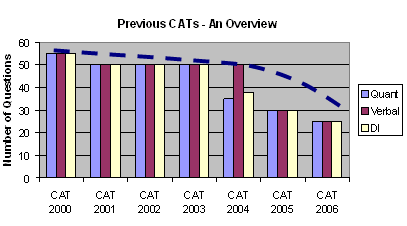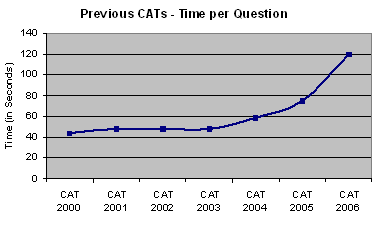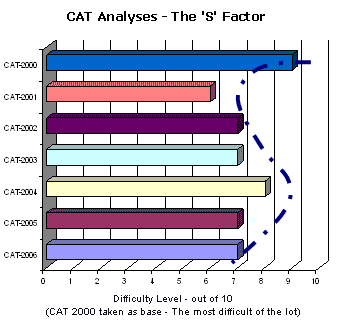|
|
| Help | |
| You are here: Rediff Home » India » Get Ahead » Careers » Cracking CAT |
|
| |||||||||||||||||||||||
|
| |||||||||||||||||||||||
Over the years, CAT has kept on bringing new surprises for test takers. We have witnessed several changes in the CAT pattern since its inception.
The greatest example is the sudden change that was brought in the tradition of giving equal number of questions in each section in CAT 2004 together with the change in the internal weightage of the questions.
This was highly surprising for the test takers who had become accustomed to attempting the CAT with questions carrying equal weightage. They never practised on a new CAT pattern until the C-Day in 2004.
Hence it becomes very important to have an overview of the last CATs before sitting for CAT 2007.
The examination experts at TCY have summarised the last 7 CATs in order to study trend. The summary will help us evaluate our preparation vis-�-vis the different types of CAT that happened in the past.
The Following table sums up the "Surprise" factor that has always made CAT a bit difficult to handle, even though the questions in it may not be that difficult.
An overview: See attached Excel sheet
An overview of the decreasing number of questions in a CAT on one side and increasing time per question on the other since 2000 shows that the trend is for good. The trend can be extrapolated further to predict that CAT 2007 may be a relief for the test takers as regards the total time they will get to solve a question.
However, the attached table also shows that beyond CAT 2003 all the questions do not carry the same weightage. There had been an introduction and subsequent internal changes in the weightage of the questions in CAT 2004, 2005 and 2006.
This makes it important for the test taker to practise choosing the right questions to attempt in the round one and two of his attempt.


The changing levels of difficulty
Looking at the difficulty level column in table prepared by TCY experts, one finds that CAT 2000 was the most difficult of the lot. Hence analyses of the previous CAT patterns as regards the difficulty level of the sections (and for that matter, the complete test) can be done in a scale of 10 by taking CAT 2000 as the most difficult (Scoring 9). Let's just have a brief review of the same.

Hence the bar graph above shows that barring CAT 2000 and 2004 all the CATs stand at 7 on the scale of 10. It is highly recommended to that CAT aspirants that they must have a look over the two most difficult CATs in order to counter the effects of a difficult CAT pattern.
To sum up it is seen that over the period of time, overall CAT difficulty level in terms of the questions have remained more or less same but it is the Surprise factor which is making students nervous and thus adding to the difficulty level of CAT. Therefore, a review of all the previous CAT (especially CAT 2000 and 2004) is vital to give a finishing touch to your preparation.
Munish Kumar is an examination expert with Top Careers & You. He can be contacted at tcychd@tcyonline.com.
To gain more from the recommendations of TCY experts on changing patterns of CAT, visit www.tcyonline.com and attend a Web-Seminar in a virtual classroom atmosphere.
|
|
| © 2007 Rediff.com India Limited. All Rights Reserved. Disclaimer | Feedback |